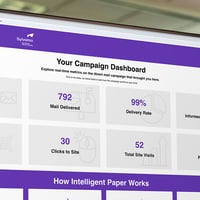Accent On: Vote-By-Mail
WHAT WOULD A MAIL-IN ELECTION IN 2020 MEAN FOR PRINT?
The upcoming presidential election is just one of the many facets of our daily lives that have been complicated by the COVID-19 pandemic. Even as some states reopen, social distancing protocols are still in place across the country, and many states are preparing for the November 3 election by expanding their vote-by-mail capacities.
Unlike absentee ballots, which traditionally require the voter to provide a reason for why they can’t vote in person, vote-by-mail means sending every registered voter a ballot in the mail by default. In vote-by-mail states, voters still have the option to vote in person, but voters can also opt to skip the polling place and send in their ballot instead.

Vote-by-mail is already the norm for residents in Washington, Oregon, Utah, Colorado, and Hawaii, but now pandemic-related health and logistical concerns have led election officials in several other states to seek to expand the practice. In 2016, nearly a quarter of the 136 million presidential ballots were mailed in. This year, that percentage could double. And in a year where Americans will decide not only on their president but 35 Senators, all 435 members of the House of Representatives, and countless local races, more states making the switch to mail-in ballots will have ripple effects across industries. One industry that will feel the impact in a big way? Print.
In a timeline developed by the federal Joint COVID Working Group that charts the path for broadly expanding vote-by-mail, researchers listed dozens of production steps that would depend upon vendors, including the design and production of millions of ballots, envelopes and inserts. According to the Brennan Center for Justice, ensuring that vote-by-mail is available to all voters could cost as much as $1.4 billion, with as much as $89 million going towards ballot printing nationwide.
This work will fall to qualified, experienced printers who understand that effective and engaging design is essential to facilitating vote-by-mail and reducing postage costs. Ballots must be obviously government-issued so that they don’t get thrown out, and they need to have clear instructions directing the voter on how to fill out and return the ballot. Furthermore, each piece of mail needs individualized voter identification so that every person receives their intended ballot, and they need to be designed and printed with postal automation equipment in mind.
And the implications extend beyond ballots. Other types of political mail are likely to surge in popularity, as social distancing guidelines are expected to continue into the summer, which will put a damper on in-person canvassing. For those looking to design and print winning campaign mailers, we’ve got a guide for that.
No matter how the election is conducted, securing a high-quality and reliable source of paper will be essential for printers and states alike. After all, a majority of in-person voting machines use paper for either a paper audit trail or to print a copy of the ballot to be hand-checked. Working with over 100,000 suppliers, Sylvamo's supply chain is one that printers can rely upon in times of great demand. Plus, when sourcing paper for the election, knowing that your paper is made in the USA — supporting local communities and employing thousands of Americans — is all the more important.
Want to learn more about bringing the right paper to elections nationwide? Request the 2020 Sylvamo Election Season Voter Guide to see a sample of Sylvamo's top ballot stocks.





.png?width=1000&name=IP-Elections_1000px%20(1).png)
